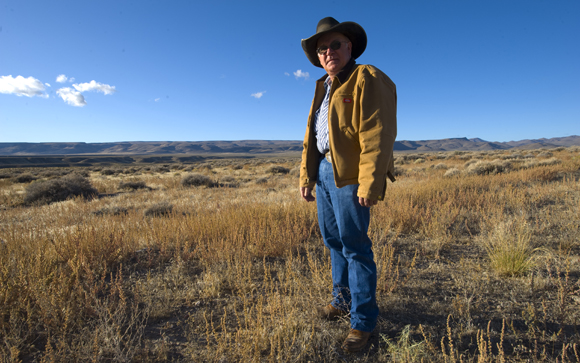| Sun | Mon | Tue | Wed | Thu | Fri | Sat |
|---|---|---|---|---|---|---|
| 1 | 2 | 3 | 4 | 5 | ||
| 6 | 7 | 8 | 9 | 10 | 11 | 12 |
| 13 | 14 | 15 | 16 | 17 | 18 | 19 |
| 20 | 21 | 22 | 23 | 24 | 25 | 26 |
| 27 | 28 | 29 | 30 | 31 |
CATEGORIES
RECENT ENTRIES
BLOG ROLL
Firestorm

“Jon Marvel’s going to be real proud when all this country is black from fire,” says Eric Davis, motioning past his pickup's windshield and the snaking asphalt to the sagebrush and grass on the hillside beyond. A rancher in southwestern Idaho's high desert, Davis has seen, and fought, his share of wildfires—“Our winter range burns about every third year”—and, like most ranchers, he believes in the power of livestock grazing to temper fire’s severity.
Environmentalist Jon Marvel, AB’72, does not.
In the Magazine’s Jan–Feb profile of Marvel, who seeks to abolish livestock grazing on 250 million acres of Western public lands, there wasn't much room to get into wildfires, an issue that, like every aspect of the grazing debate, is complicated by politics, emotion, history, and competing notions of ecological truth. Fire is a subject ranchers often bring up to illustrate how they believe Marvel’s approach would harm the land he means to rescue. Allowing cattle and sheep to clear out the tallest, driest leaves—what ranchers call "decadent" growth—reduces the “fuel load” available to fire. Grazed land, they contend, burns in a way that is more controllable than fields left unmanaged and untended. "The amount of fuel that’s on the ground determines the heat intensity of the fire," says Chad Gibson, a range-management scientist and former spokesman for the Owyhee Cattlemen's Association. "And the hotter it gets, the more impact it has on vegetation."
Inevitably, ranchers' talk turns to the Murphy Complex Fire of 2007. That summer, lightning strikes along the Idaho-Nevada border ignited a blaze that burned unchecked for two weeks. Dry, hot winds blew the fire forward, and the flames became so intense that stands of sagebrush exploded in its path. Before it was over, more than 650,000 acres had gone up in smoke. It was the largest fire Idaho had seen since 1910. Much of the incinerated ground had remained ungrazed for a decade, entangled in lawsuits brought by Marvel. In the fire's aftermath, Idaho Governor Butch Otter and Senators Larry Craig and Mike Crapo laid the blame at environmentalists’ feet, claiming that more grazing might have meant less disaster.
Davis and his neighbor and fellow rancher Charles Lyons seconded that assessment. “I could have guaranteed you that thing was going to burn, and it did,” Lyons says. “And what was the cost? Who knows. But it invited a whole lot of invasive species,” including, he adds, the highly flammable infiltrator cheatgrass, considered a scourge by environmentalists and ranchers alike. "And hell," Lyons continues, "the sage chicken”—an endangered bird that Marvel has launched a legal fight to protect—“it burned up all their habitat too.”
Marvel challenged ranchers to prove their point, to produce evidence that grazing inhibits wildfires. Soon enough, some proof arrived, although it hardly settled the dispute. In 2008 a study by scientists at the universities of Idaho and Nevada, the U.S. Geological Survey, and the Bureau of Land Management found that grazing levels had a “negligible” effect on the size of the Murphy fire. The wind was just too high, the fire too hot. But the same study also suggested that under more moderate weather conditions, grazing can perhaps slow a fire's spread and dampen the intensity of its advancing front line. Meanwhile, a 14-year study released in 2009 by the USDA's Agricultural Research Service found that grazed rangelands recover more effectively from fire than those kept free of livestock.
Botanist Beth Painter believes the definitive data on grazing and wildfires doesn't yet exist. “We don’t have really good documentation,” she says. “When it’s not wind-driven and there aren’t extreme weather conditions, we simply don’t have enough data." Painter, who learned to ride a horse before she could walk, grew up ranching in Wyoming, and her family has been raising cattle out West since the 1880s. When her PhD research began leading her inexorably toward grazing's negative consequences, it came at first, she says, as a "shock to the system." Now she serves on the advisory board of Marvel's environmental organization, Western Watersheds Project.
In the end, Painter says, the answers to the wildfire issue aren't likely to be clear cut.
"Yes," she says, the ground "probably wouldn’t carry a fire if there were no plants out there, if it looked like a feedlot." Or maybe it would: in California's coastal shrublands, where wildfires are common, she has found that the same area can burn two years in a row, before vegetation has a chance to return. "So fuel load is kind of a question.” In addition, the dried leaves that ranchers call "decadent" might actually shield a plant during a fire. "Sometimes it needs that standing material across the top to protect it from the soil overheating," Painter says. "Soils, if they get hot enough, will caramelize."
"It's a very complex question to approach, whether or not cattle have an impact on fire," she concludes. "We have to follow the science."
Lydialyle Gibson
March 3, 2010
